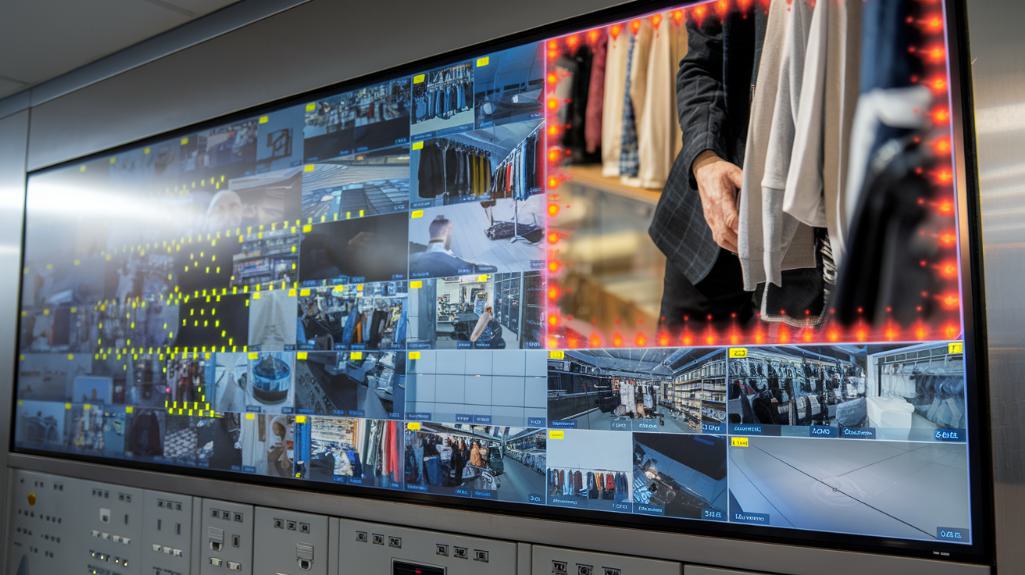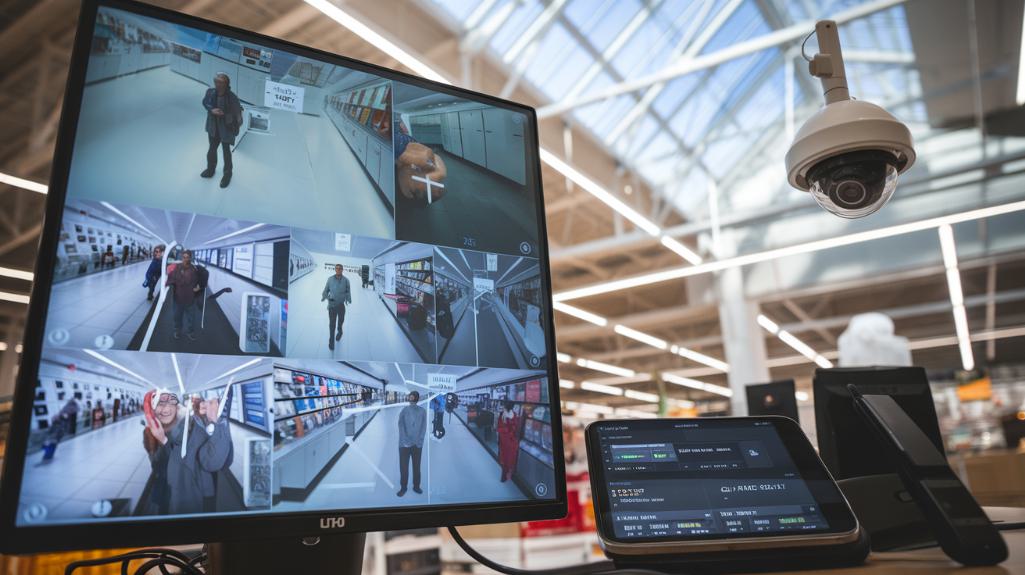Automated alert systems serve as a critical defense against retail theft by integrating AI analytics, video surveillance, and electronic monitoring. These systems analyze behavioral patterns in real-time, detect suspicious activities, and instantly notify security personnel of potential threats. With cloud-based storage and advanced integration capabilities, retailers can reduce shrinkage by up to 30% while improving response times. Understanding the extensive features of these systems reveals their full potential in combating organized retail crime.
Key Takeaways
- Automated alert systems combine AI analytics with video surveillance to instantly detect and notify staff of suspicious behavior patterns.
- Real-time monitoring through integrated security platforms reduces inventory shrinkage by up to 30% through immediate response capabilities.
- AI-powered analytics decrease false alarms by 40% while improving accuracy in identifying genuine theft attempts.
- Cloud-based storage enables historical data analysis to identify patterns and optimize theft prevention strategies over time.
- Integration with existing security infrastructure creates a comprehensive defense system connecting EAS, RFID, and access control technologies.
Understanding Modern Retail Theft Challenges and Trends

While retail theft has long challenged business owners, recent data reveals an unprecedented surge in organized retail theft that demands immediate attention and strategic response. The 93% increase in ORT incidents since 2019 has fundamentally transformed the landscape of retail theft prevention, pushing businesses to seek advanced technology solutions.
Analysis of current trends shows critical gaps in loss prevention strategies, particularly in incident reporting systems. With 56% of retailers forgoing theft reports due to time constraints, the need for streamlined, real-time data collection becomes evident.
The $94.5 billion loss from shrinkage in 2021 underscores the necessity for integrated security systems that enhance both inventory management and customer experience. This evolving threat landscape requires retailers to adopt automated solutions that can identify, track, and respond to theft incidents more efficiently, such as the use of AI-powered solutions that prevent theft and enhance shelf-level security.
Key Components of Automated Alert Systems
Modern automated alert systems comprise several essential components that work in concert to create a detailed retail theft prevention framework. The integration of real-time monitoring with AI analytics enables swift detection and response to suspicious activities in retail environments.
| Component | Function |
|---|---|
| AI Analytics | Analyzes behavioral patterns and identifies potential threats |
| Video Surveillance | Provides visual monitoring and documentation of incidents |
| EAS Integration | Detects product tag violations and unauthorized removals |
| Mobile Notifications | Delivers instant alerts to security personnel |
| Cloud Storage | Archives incident data for pattern analysis and reporting |
These interconnected components establish a thorough security infrastructure, enhancing communication between systems and staff. The combination of automated monitoring and cloud-based storage facilitates both immediate response to theft attempts and long-term analysis of prevention strategies, ultimately strengthening retail security operations. Furthermore, integrating real-time alerts into the system allows for timely notifications that enhance the overall security measures in place.
Real-Time Monitoring and Response Protocols
Building upon the established components, real-time monitoring and response protocols form the operational backbone of retail theft prevention systems.
AI-powered analytics continuously scan retail environments for suspicious behavior, integrating video surveillance with automated alert systems to notify security personnel instantly.
Electronic article surveillance works in conjunction with real-time monitoring to detect unauthorized item removal, while cloud-based platforms guarantee surveillance footage and alerts remain accessible to security teams regardless of location.
The system analyzes various behavioral patterns, including loitering and rapid item removal, triggering immediate alerts when potential theft scenarios are identified.
This all-encompassing approach to theft prevention has proven effective, with retailers reporting significant reductions in losses through faster response times and enhanced deterrence capabilities.
Integration With Existing Security Infrastructure

Through sophisticated system architecture, automated alert systems seamlessly interface with established security infrastructure, creating a unified defense against retail theft.
The integration enables thorough theft detection by combining video surveillance feeds with Electronic Article Surveillance and RFID technology to track merchandise movement and identify suspicious activities in real-time.
Cloud-based solutions enhance this integration by storing historical data for pattern analysis, while AI analytics process real-time data from multiple security devices simultaneously.
The system's connection with access control systems provides additional security layers, monitoring restricted areas and triggering immediate alerts upon unauthorized entry attempts.
This multi-layered approach optimizes theft prevention by leveraging existing security investments while introducing advanced monitoring capabilities, resulting in more accurate detection and faster response times to potential security breaches.
Measuring Success and Optimizing Alert Effectiveness
Effective measurement of automated alert system performance requires thorough analysis of key metrics and continuous refinement of response protocols.
Real-time alerts integrated with AI analytics demonstrate significant impact on retail theft prevention, reducing inventory loss by 30% while optimizing security personnel deployment.
Key success indicators include:
- 40% reduction in false alarm responses through AI-enhanced system accuracy
- 25% improvement in theft deterrence with immediate staff notification
- 20% better detection of organized retail crime through customized alert settings
Retailers can optimize effectiveness by regularly analyzing incident data and adjusting alert parameters based on store-specific patterns.
This data-driven approach enables security teams to maintain system accuracy while adapting to emerging theft tactics, ensuring sustained protection of high-risk merchandise and overall retail assets.
Frequently Asked Questions
What Is the Average Cost of Implementing an Automated Alert System?
Implementation costs for automated alert systems typically range from $25,000 to $150,000, varying based on system integration, hardware expenses, software licensing fees, scalability options, and ongoing maintenance requirements.
How Long Does Staff Training Typically Take for Alert System Operation?
Staff training duration typically ranges from 2-4 weeks, encompassing system familiarity modules, operational readiness assessments, and ongoing education. Training methods focus on staff efficiency through hands-on learning and performance evaluation.
Can Automated Alerts Distinguish Between Employee Theft and Customer Theft?
Modern surveillance technology utilizes data analysis to differentiate employee behavior from customer theft patterns, enhancing detection accuracy through customized alert thresholds, enabling targeted loss prevention responses based on security training protocols.
What Backup Systems Ensure Alerts Function During Power or Internet Outages?
Backup power systems, battery reserves, and failover solutions maintain alert functionality during outages. Internet redundancy protocols guarantee data integrity, while systematic alert testing validates system reliability and supports thorough outage response procedures.
How Do Privacy Laws Affect the Deployment of Automated Alert Systems?
Privacy concerns require strict legal compliance with state laws regarding surveillance limitations, customer consent, and data protection. Information security protocols must address biometric regulations and ethical implications of employee monitoring.
Conclusion
Automated alert systems represent a critical advancement in retail loss prevention, offering scalable, data-driven protection against evolving theft tactics. Through strategic integration with existing security infrastructure and continuous optimization of response protocols, these systems deliver measurable reductions in shrinkage while enhancing operational efficiency. Their implementation remains essential for retailers seeking to maintain profitability and protect assets in an increasingly complex security landscape.



